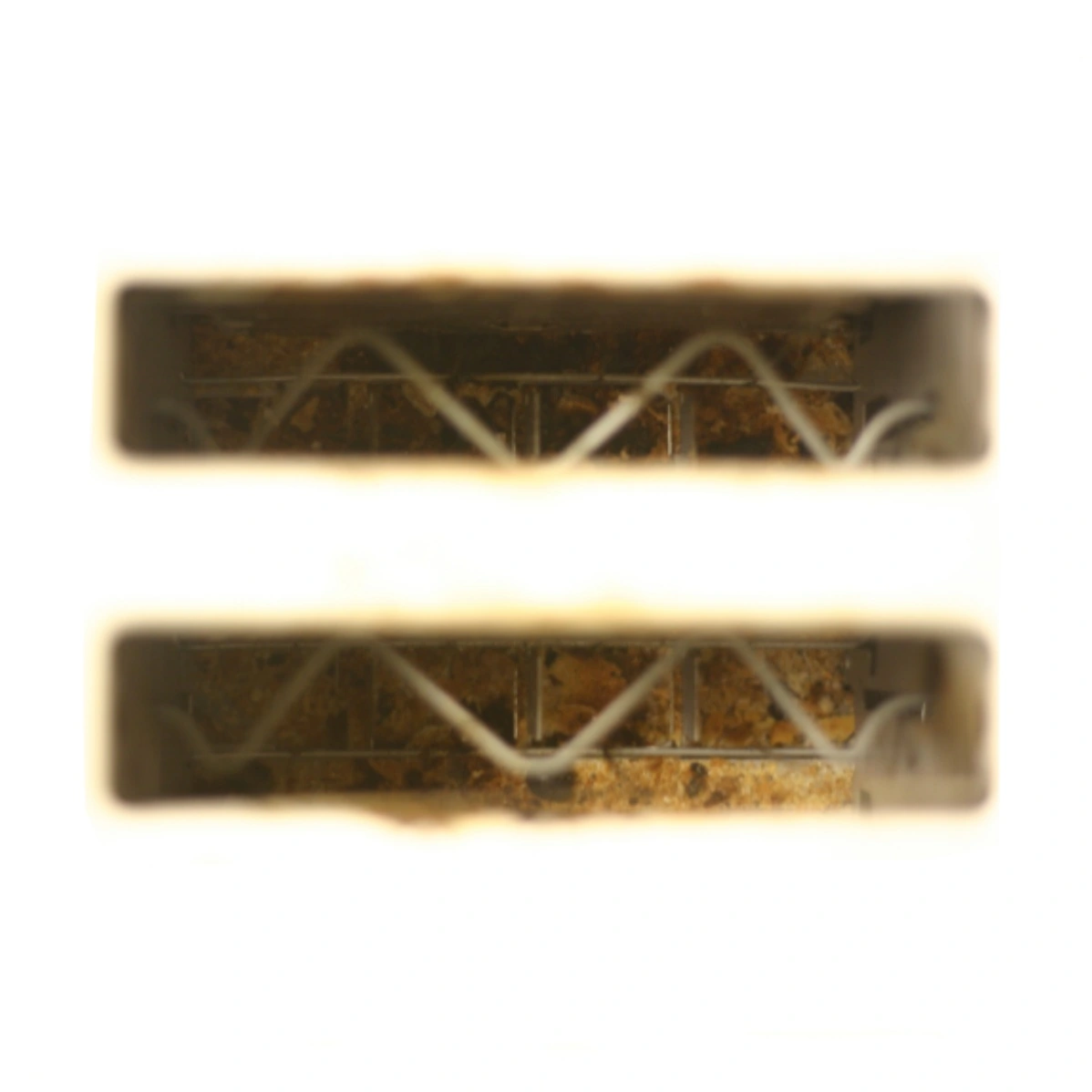in both scenarios developers eventually buy up the entire island and fill it with either
The picture on the left is just an argument against lawns.
Right? And also…who needs space between two homes if there are no lawns? Just moosh all the outer walls together.
Come to think of it…that’s gonna result in a ridiculously long line of houses. Maybe we could moosh roofs and bottom floors and stack 'em up a bit to make the line of houses only a half to a third as long, and then leave a little space between Consecutive House Stacks™️ - y’know, so that there’ll room for more windows.
Lawns aren’t the reason people want to have space from their neighbors.
It’s amazing what insulation and proper sound proofing can do. Never lived in thicker walls than here in Germany. Other than the blasted church bells, it’d be hard to convince me I was living next to people if the windows were opaque.
And why don’t we stick the whole thing underground to further minimize damage to the landscape. Besides it’s way cooler to be called a vault dweller than a condo resident.
Partially, even if you got rid of the lawns the houses would still take up significantly more space for both the road infrastructure as well as the houses themselves.
The way i see it is people prefer to fence themselves from the world in their tiny square, rather than enjoy a larger piece of land they have to share.
But then you have to live in an apartment…
The neighbors kids who live above you will stomp around at 2:00am.
The neighbors below you will complain when you make the slightest noise.
I guess that’s just an argument for better made apartments.
That’s really the foundational problem. If you could exist without bugging or being bugged by the neighbors dense housing would be so much more appealing
IMO this is a universal problem. I’ve had neighbours in a single family house that choose to mow their lawn at 7am on a Saturday and have a very loud pickup truck that I can hear start up any time they drive it.
This is absolutely correct.
I live now in a well-made townhouse. I can’t hear the neighbors, ever, even the living room, or the kitchen. Or the bedroom! I love this place compared to my last crappy townhouse, or any apartment I’ve ever been in, ever.
Unfortunately, where I live it’s very hard to find a well-made apartment or townhouse. I love the idea of an apartment or townhouse where I couldn’t hear the neighbours no matter what they were doing, and I couldn’t smell their cooking, or be exposed to smoke when they’re smoking, and so-on. But, that just isn’t realistic. Even if laws were passed to make that a requirement as of today, it would be decades for the existing housing stock to be sold off.
These threads are full of people making the straight-up weakest arguments for destroying nature…
“…but privacy and noise!”
Ugh, just take all that money you would have spent on the ridiculous driveways, extra lengths of road, utilities, and lawn care and put it into higher quality building materials for the apartments/townhouses.
We build crap quality places in the US and all I hear from my fellow countrymen is “we can’t (or don’t want to) do it any other way”.
deleted by creator
If I could live in the city and never see another person I think I wouldn’t mind it.
No, wait, still not enough trees or animals or stars in the sky.
That’s why we should build “luxury” apartment blocks in nature with high ceilings and very good noise cancellation, surrounded by agriculture and food forests, ideally growing their own food. Everyone gets a killer view and can quickly go out into nature.
And then connect these big ass apartment blocks with underground train.
If it were like that you’d find me living in the food forest and not the apartment.
deleted by creator
Seriously. Solid concrete apartments are so impervious to noise that the only times i hear any noise other than them dropping anvils on the floor is when it comes through an open window! I’m more annoyed by people in the room next to me than i am by anyone outside the apartment.
We can’t live in an apartment because it will always have bad insulation. We should all live in single unit housing with… checks the quality of insulation in your average 1970s ranch house oh shit, oh fuck.
Also, gotta say, love to live in a street level neighborhood Cul-de-sac with that one guy revving his motorbike at 3am. Single pane glass, noisy neighbors, and god help you during July 4th or Jan 1st when someone gets ahold of fireworks.
But for some reason, we completely forget about this shit when we talk about apartments. Like the suburbs - particularly the corners near intersections or school yards or big churches or highway on-ramps - aren’t routinely noisy af.
Most of my apartment neighbors are actually really cool, chill people. There’s a handful of people who stink, but like… Oh well?? That’s living around other humans? You adapt to the shitty ones and get along with the good ones.
If you run around assuming all your apartment neighbors will forever be annoying, you’ll never get to know any that aren’t. Same with neighbors in the suburbs. Being around humans can suck sometimes, but if you look you can often find decent people.
I’ve met more decent wild animals than I have people.
Ok, misanthrope.
You say that like it’s an insult.
Someone who hates or distrusts humankind certainly isn’t a positive trait.
Awww surely not!
Ever heard that quote, paraphrasing the start of it:
You run into a jerk in the morning, you ran into a jerk.
(Maybe you know the rest) If you give that some thought for the rest of the week (assuming you’re out and about), interested to hear any thoughts on it :)
Part of the reason I hate people is I put a ton of effort into trying not to be a jerk, stressing myself out with constant worry from monitoring my behavior at all times, but other people don’t seem to give anyone else the same courtesy.
And that doesn’t even get into how hard it is for me to relate to almost everyone. I watch weird TV shows, listen to weird music, read weird books, and have weird hobbies. Outside of the weather I don’t really have anything to talk to them about, despite their seemingly constant need for interaction.
The suburbs are noisy as fuck. That’s why I want to live in the middle of nowhere.
I have been to a high-density suburb that is honestly not that far from being the second image, and it was literally so dead quiet that i could reliably use the distant sound of the highway to orient myself.
try: Alaska
you can have trees with people or trees without people, we have train, boats, and airports. Enjoy the tundras full of moss and few people, the largest city in the United States (by area) and the reasonably tall mountains.
You joke but the Canadian Rockies are pretty high on my list of places to wander naked until I die.
The thing is, you can’t really engineer against anti-social behavior. For every better made apartment you will find that there is an even bigger anti-social idiot who still manages to make life hell for their neighbors.
I’m pretty blessed with my mostly boomer neighbors (🤞) who don’t make a peep after 10PM, but my girlfriend has had some shitty neighbors even though her apartment is pretty well made. Sound insulation between apartments is no match for cigarette and marijuana smoke wafting in from the balcony below any time you want to open the window to air out, or if, heavens forbid, you want to sleep with the window open in the summer, nor does it help much if they are partying and speaking loudly on their balcony until 4AM on weekdays. And then I’m not even getting into how they’re treating shared spaces.
The proximity makes everything so much worse than it would be with a house, at some point only adding distance helps.
I’ve lived in shitty apartments but dated two people who lived in “modern” high rise appartments. In mine I heard the neighbours occasionally since they were clearly old motels that they half arsed into units. The modern apartments I practically never heard anyone.
Though “modern” apartment generally price out people who are up all hours making noise it’s more the fact that these appartments usually have body corporates or people that live on site. Being the typical “up all hours stomping around” type would be a quick way to have your lease terminated.
Edit: Duh and the super obvious thing I forgot, improved sound insulation in modern apartments I imagine as well.
I grew up between a big house with it’s own forest, and a town house. At this point in my life, I have spent more time living in apartments, and the last 4 years living in studios. Gotta say, I have no desire to move into a house at any point. Having an apartment in a well built city with good public transport is just way nicer.
for a while now i’ve maintained that commie blocks (at least over here) are some of the best places to live, and i have to conclude that the only reason people think most other areas are at all appealing is because they have simply never actually been in the commie block areas.
It’s like how my dad had never once even considered the notion of riding a bike, then one day i convinced him to buy an e-bike and since that day he has driven a car… literally 3 times, i think. Once you actually consider the merits of it it’s so obviously better.
Yeah. I’ve lived in one in eastern Germany for a few weeks at one point. It was in a park, which had seating, locations for BBQ, playgrounds, and all streets around where very reduced speed. The flat was sized and partitioned well. Insulation sucked, though I’m pretty sure renovating one to modern standards is cheaper than leveling and replacing it.
Concrete framed buildings help a lot with this. Other noise proof options are out there as well
My favorite is a few hundred meters of trees with a fence and stone walls
This has literally been a non-issue for me in every apartment I’ve lived in for the last 10 years here in Sweden. You probably need some better building codes, this is a solved problem.
this is a solved problem
LOL no, it’s a solved problem where you are
so you’re agreeing it’s a solved problem then, just that wherever you live is refusing to implement it.
I’ll rephrase - this is a problem that has an established solution that you can easily copy.
I’ve lived in an apartment and I just can’t do it. I hated every day in it.
I just moved from an apartment to a house.
If the apartment had the same floor space and the city actually accommodated my hobbies (I need a large garage to work on cars and finish fixing a boat) then I would’ve gladly stayed.
However. Apartments above 60m² are rare and expensive, and all garages/industrial sites are unfavorable because you can put another bloc or supermarket in there. The cities became living hubs for corporate workers whose entire lives can be crammed into a 40 meter apartment and their only entertainment is a depression rectangle or a gaming console.
It depends also on the type of houses. It’s not the same a cabin in the woods and a house with a garden.
Yeah give my 5th floor apartment a back yard to garden in and the we’ll talk.
https://en.wikipedia.org/wiki/Community_gardening
Very common in and around the old Soviet style Eastern European blocs. The style of construction was known as “Towers in the Park” and was often paired with rail stops and local commercial centers for the convenience of pedestrians.
that’s called terraced housing and it’s really astoundingly enjoyable.
Check out Habitat 67 in Montreal - an architectural student solved this in the 60s. Apartments where everybody gets their own rooftop terrace. Given the funding, the original plan was for a 30-story terraced hill of mixed-use and apartments in an A-frame with public green space underneath that mixed the density of apartments with the benefits of single family homes.
Since everybody thought he was crazy, he only got a fraction of the funding for what he ended up building for the 1967 World’s Fair, but those apartments have the longest occupancy time of any building in Canada (some seeing 2 or 3 generations living in them) and a 5-year waiting list on units.
Last year, a 3d model of the original concept was released for Unreal Engine: www.unrealengine.com/en-US/hillside
https://en.wikipedia.org/wiki/Allotment_(gardening)
This is a solved problem.
You see one apartment building. A property developer sees room for 100 apartment buildings.
So um, why are the houses and nature mutually exclusive? I live in a suburban detached single family home, and my whole neighborhood is filled with trees, wildlife and even a tree lined creek that separates the back yards on my street from the back yards on the opposite side. You can’t even see my actual yard from google maps because it’s nearly entirely covered by tree canopy (at 6pm in summer my yard is 100% shaded). We have all sorts of wildlife including deer, foxes, owls, frogs, mallards, rabbits, squirrels, etc.
While I agree that we do need more housing options of all sorts, I don’t for a second agree that nature and suburban housing are mutually exclusive. We just need to stop tearing down all the trees when we build, and plan better.
Don’t forget the huge energy savings (heating/cooling, transportation, infrastructure) by having denser housing. It isn’t just a measurement of “I can see trees,” but all the daily human activities that have a reduced environmental impact in denser development. It’s counter-intuitive, but rural areas that are “nearer to nature” are often worse for the environment.
There is probably a break-even point, I don’t think everyone living in skyscrapers is ecologically ideal and I wouldn’t want to live there anyway. But medium-density development with multi-unit (shared wall) buildings allows huge energy costs, while also making public transit more viable and providing a tax base that actually pays for its own infrastructure.
Based on your description we might be neighbors
I think the point of the island is to show that when you have limited space, residential density really matters. Even if you took away all the concrete, spacing, etc between houses in this example and just out 100 ranch style homes in a corner with no spacing in between them, it would leave room for significantly less nature.
Your neighborhood sounds beautiful, and that’s great, but that ratio between nature and residents is probably being achieved with more land than if high density residential housing was in place.
why
Well, you could count the trees on the right and find a way to fit them in between the houses on the left.
Removed by mod
Removed by mod
Removed by mod
He-She is just telling that there is a difference between a garden and an actual wild nature space. Gardens are manicured environments with a fraction of biodiversity that are made to serve human needs, and also frequently require constant maintenance and resource consumption on garden tools, fertilizers, etc, and frequently are changed whenever the house changes owner or tenant. They do not contribute to nature preservation at all actually, they just provide more comfort to the inhabitants like some trees for shading. A real wild nature space demands a lot of continuous space devoid or almost devoid of human presence or interference, like a whole Manhattan island of trees that will not be cut, and no fertilizer maintenance at all, and big animals that are dangerous to humans such as wolves, bears, moose, etc.
If the apartments are no shoe boxes and have lavishly big (garden) balconies I’m all in. The space should be around 100-120 qm each with flexible drywall placement for individual footprints.
I love living in a walkable city but I envy a friend of mine a little bit, who exits his apartment into a market center with cafes, shops, supermarkets, barber, doctors etc.
Logic here is broken because we don’t make these decisions anyway. A developer will instead put 30 apartment buildings while chopping down anything that gets in the way, then charge more for rent than you’d be charged for the mortgage on the house. There’s also the fact that this picture assumes every family on the left pic doesn’t give a fuck about free scaping, preserving trees, or planting new ones? Idk, whole thing is jacked.
It feels like whoever made this only sees those large suburban sprawls in the South West of the US where it’s all flat desert. Or the suburbs built on large tracts of farmland that had trees taken down many years before for crops.
Housing development is expensive when you have to cut down and uproot large tracts of forest. They’re not willing to do that unless there is a high rate of return… Such as an apartment building with a hundred tenants.
A lot of people in this thread are mistaking the map for the territory. Like yes, obviously neither the development on the right, or the left would actually happen in real life, because why are these people even on the island? What do they eat? What do they drink? Where do they work? The sole statement of the graphic is that dense developments have a reduced impact on nature compared to sparse developments. Discussing the logistics would exceed what can be conveyed by such a format.
If the island were 100 times larger, the houses would take 1% of the land area, leaving 99%. The apartment complex would take up .04%, leaving 99.96%, which isn’t much of an improvement. The proportions of our planet are much closer to my scenario than this made up island. That’s a reason why we might not “prefer apartments in our own town.”
There are good reasons you might want density, this just isn’t one of them.
Yeah, but most people don’t live in that other 90% . Most people live in urban and suburban areas where most if not all of the land is privately owned. Because of this the problem shown of fitting 100 households into 25 acres is way more common than your scenario of fitting 100 households on 2500 acres
And having trees and nature near urban venters is very much desirable, to help with air pollution (tho really not a lot), heat concentration and humidity.
If the island were 100 times larger, the houses would take 1% of the land area, leaving 99%.
Singapore government: if only.
Also wildlife, carbon capturing, and distance to everything. There’s reason why denser city is easier to go around, in this island, you might not even need a car.
Easier travel is definitely a great reason to increase density. Walking & biking > cars
There is approximately 15.77B acres of livable land and there are 8.2B people so if each person had just 1/4 acre that would be 13% vs if you gave each person 2000 sqft it would only be 2%. Then you need to factor in how to built transit for low density and how many more stores you need due to the lower density and you can see that it would be much better for the environment if we had higher density
That’s the difference between America and Western Europe. Western Europe is already mostly built up, they don’t have room. America does.
That’s not even remotely true. Do Americans actually believe this?
Yea, everything is pretty full here. We have plenty of nature, but there’s always traces of civilization.
I often miss the vastness of nature. Been to Alaska some years ago and being in nature is an entirely different feeling.
Spoiler: No it isn’t.
Renting sucks and relying on a landlord is awful. I bought a small house and keep my yard wild.
Co-operative run housing largely eliminates those problems.
Cool, call me when that comes to the Detroit area I guess. I’ll probably be dead though cuz it ain’t happening.
Sounds like the other hell on earth … an hoa
housing co-ops are basically the standard here in sweden and it’s perfectly fine, just because america makes things suck doesn’t mean they have to inherently be bad. Obviously if you execute a concept in the worst way imaginable it’s going to suck, that’s not rocket science.
Why does renting have to be the automatic assumption? We’re simply talking about two different ways to organize living space, not how it’s financed. Shit, we should take a page out of Finland’s book, and make some actually really good public housing and make it available to everyone.
Because capitalism.
Having renting be the default for apartments is part of the problem. It is very normal where I live that a developer build an apartment building and the sells the apartments to individuals who own the living space and co-own and maintain the shared spaces. The developer takes the winnings and never interferes with the building again.
But then you have to deal with the politics of running the complex.
It’s like having an HOA but even more impactful on your daily life since you have to walk through the common area and such - at least with a standalone home you own the land and are directly connected to a public street.
Having lived both in buildings where my family owned one apartment, and houses where there was an HOA, i can tell you that the politics of the apartment building was not even close to how insne an HOA is. it was mostly taking about the budget, prioritizing repairs, and security
If you buy into a poorly managed building though you are screwed. Many buildings don’t keep enough cash on hand for unexpected bills because they want to keep the fees low for residents. Then an elevator breaks, sewage backs up, someone floods their apartment, and all of a sudden there’s a $20,000 bill that everyone has to pony up money for.
that is true, we had to change administrators one time and it was not an easy process. my comment was mostly that the blanket statement of “politics in an apartment complex are worse that an HOA” is not true, it depends on the building and the HOA
There’s a principle in economic analysis called “Ceteri paribus”, “other things equal”. So, if you’re renting in the image on the right, you’re also renting on the image on the left.
At least in my country it is very normal to own your apartment
In the US you can be kicked out of your apartment with only 60 days of warning without cause (the owners only have to claim they need it for personal use or some other bs).
That is part of why people hate renting. 60 days isn’t enough time to find a new place, pack everything up, and move all while working 50 hours a week.
You lost me at buying a small house
Owning sucks too. Shit is always breaking, it’s expensive to fix and nobody else will handle it for you. Just paying for lawncare is bleeding me dry, and I don’t even use the lawn… but the city/police get angry when I don’t cut it.
I have both owned and rented, and there is no comparison. Owning is a million times better. Not having a landlord that can just raise the rent or kick you out whenever they feel like it, plus the freedom to do whatever you want with the place, plus the almost certainty that your house is appreciating and you’re not constantly throwing massive amounts of money in the fucking toilet.
There is nothing about owning a house that even approaches the cost of renting unless you don’t know how to do even basic DIY shit and you don’t have any friends who can.
almost certainty that your house is appreciating and you’re not constantly throwing massive amounts of money in the fucking toilet.
Hard disagree, as I have had the exact opposites happen and know many others in the same boat. Both houses I sold were at a loss, after I got sick of things breaking all the time and being too expensive to fix.
unless you don’t know how to do even basic DIY shit and you don’t have any friends who can.
Or you are disabled and don’t have anyone to help.
I am disabled, and the work needed to upkeep a house is orders of magnitude less than the stress of being forced to move every couple of years because the landlord raised the rent, or won’t upkeep the place, or they’re selling the house, or the agent takes an irrational dislike to you. I’ve had all of those happen, many of them concurrently. That’s not to mention the disability issues involved in not being able to fix your own space and solve problems that exacerbate your illness.
Not having friends is a problem that could be addressed with a stable local community, something that gets broken up when people are forced to move and can’t put down roots anywhere.
And you lost money twice? Okay, unlucky, but are you going to tell me you lost more than you would have in rent? Did you give up on owning and go back to renting, and do you prefer it? Are you telling me you made the choice to rent rather than own, or were you forced to rent by financial hardship? Or wait… do you still own and you’re just bitching about it? Why don’t you go back to renting if owning is such a burden? (EDIT: Also, in case you didn’t realise, you’ll still have to mow the lawn if you rent, so that’s a weird problem to focus on)
I owned a house outright with my partner, with no debt, but then my disability became too much for me to work, the relationship broke down, the assets were split and we both fell off the property market. All of the money we made selling the place has now disappeared into various landlords’ pockets. I’m sure I could’ve bought one of their places for all the money I’ve given them over the years. And I could’ve made a down payment once upon a time, but without a steady income I can’t get approved for a loan, yet another problem forcing me to rent. Now, any money I could’ve made a downpayment with is gone.
And before you say that this is a downside of owning, I will remind you that the problem I am describing is no longer being able to own and being forced to rent, so if that’s a problem, then renting is worse.
Oh by the way, renting is worse. It is a fucking crime against humanity. The village is gone, and landlords destroyed it. The destruction began with the fencing of the commons, that brutally violent theft by proto-capitalists from the peasants, and it’s never stopped since. It won’t stop until we organise and take back what’s ours.
Replace your lawn with white dwarf clover. It looks lawn like but doesn’t get super tall. Also it feeds the pollinators.
Edit: White dwarf clover is what people think of when they think of clover. It’s not something exotic. Do not get crimson clover and especially not red clover lol. Red clover is a perennial and gets very tall.
that would cost as much as just paying the lawn people, I can’t do it myself.
You are not thinking about the large picture.
Renting a tiller and throwing down some clover seeds is cheap compared to a lifetime of lawn people.
Just like with your first comment. Yes things break and are expensive, but you’re not throwing ~1500 a month out the window renting.
No tiller necessary.
Nah, the process you’d want to do is called over seeding. You trim the grass super super short, spread seeds, and that’s it. You can get seeds and a spreader for pretty cheap. It’s not as expensive as something like sod or ripping up your old grass.
I would still have to pay someone as like I said I cannot do it myself. Thanks for the suggestion though
No worries. I wasn’t trying to make assumptions, just point out that the process is much less involved than you’d guess given what replacing grass usually looks like.
Neither have water, so neither?
Obviously the blue part is land
Now imagine apartment buildings taking up 100% of the island and that’s what you get under the current system.
Three apartment buildings and the rest is all parking lot
Zoning bylaw might require 1.5 parking spaces per dwelling unit. Three buildings would then need 450 spaces at roughly 128 sqft. each which would take up nearly an acre and a half.
The three buildings on their own probably wouldn’t need even a single acre.
Great, that means people have a place to live.
not sure how you imagine it’s better for those people to just… not have a place to live?
Yes because housing is the only thing that matters. More houses! Cover the planet in housing!!!
Don’t have children.
so you’re literally just saying people should go homeless then, wonderful!
You are allowed to wildly infer anything you would like.
























